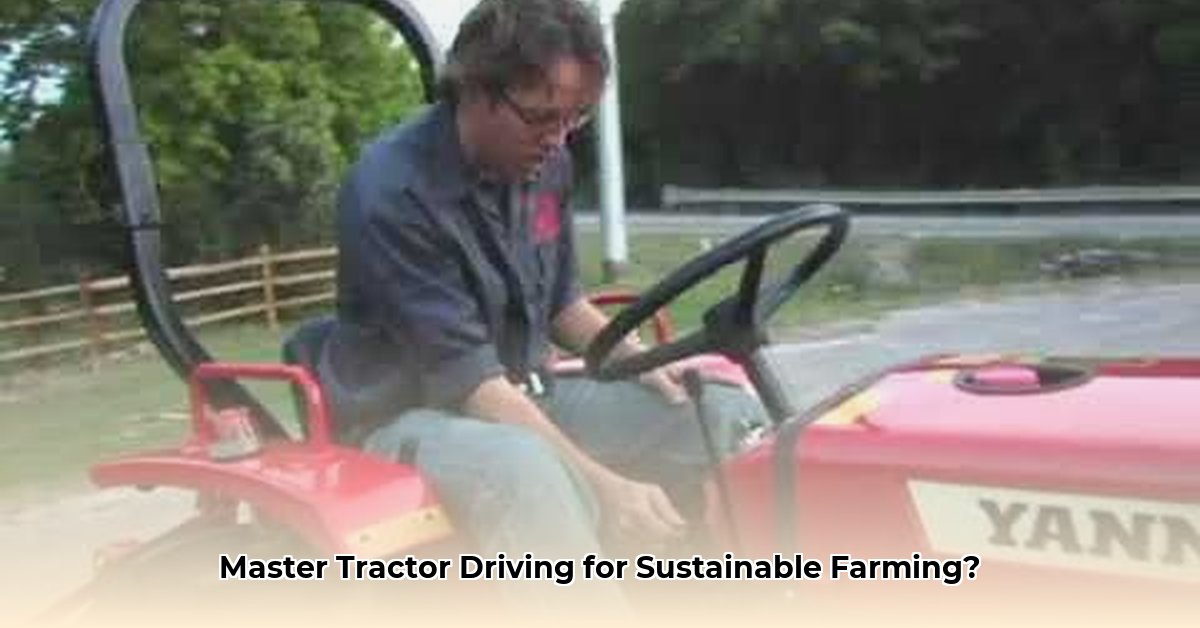
How to Operate a Tractor for Sustainable Farming
This comprehensive guide equips you with the knowledge and confidence to operate a tractor safely and sustainably, regardless of your experience level. We'll cover pre-operation checks, safe driving techniques, fuel-efficient practices, and sustainable farming methods. For more in-depth training, check out this tractor training resource.
Pre-Operation Checks: Prioritizing Safety and Efficiency
Before starting, a thorough pre-operation check is crucial – it's about safety and equipment longevity.
- Fluid Levels: Check engine oil, coolant, transmission fluid, and hydraulic fluid. Low levels lead to damage and breakdowns. Use only the recommended fluids.
- Tire Pressure: Properly inflated tires are essential for fuel efficiency and minimizing soil compaction. Underinflation wastes fuel and damages soil structure. Inspect for cuts or wear.
- Brake Check: Thoroughly test your brakes. Malfunctioning brakes pose a severe safety risk. Address any issues immediately.
- Lights and Signals: Ensure all lights and signals function correctly for safe operation, especially in low-light conditions.
- Implement Inspection: Carefully check all attached implements for secure attachment and proper function. A malfunctioning implement can cause damage or injury.
Did you know? Proper tire inflation can improve fuel efficiency by up to 10%, reducing your environmental impact and operating costs.
Operating the Tractor: A Step-by-Step Approach
Safe and efficient operation is paramount. Always wear appropriate clothing: sturdy shoes, long pants, and hearing protection.
1. Starting Up:
- Engage the parking brake firmly.
- Ensure the gear shift is in neutral.
- Consult your tractor's owner's manual for the specific starting procedure.
- Never start the tractor with anyone near the power takeoff (PTO) shaft.
2. Getting Going:
- Select the appropriate gear for the task; lower gears are needed for heavier tasks or uphill work.
- Steer smoothly and predictably, anticipating turns to avoid sudden movements. Practice in an open area first.
3. Maneuvering:
- Make smooth turns; avoid abrupt changes in direction. Tractors are less responsive than cars.
- Be mindful of surroundings; avoid obstacles and hazards.
- Exercise extra caution on slopes to prevent rollovers.
4. Bringing it to a Halt:
- Slow down gradually well before stopping.
- Engage the parking brake firmly.
- Ensure the tractor is fully stopped before disengaging implements.
- Turn off the engine.
5. Using Implements:
- Familiarize yourself with each implement’s operation, reading the manufacturer's instructions carefully.
- Securely attach implements, following manufacturer guidelines.
- Operate each implement according to its instructions.
Quantifiable Fact: Studies show that proper gear selection can increase fuel efficiency by up to 15% during fieldwork.
Sustainable Farming Practices: Environmental Responsibility
Sustainable farming is about the long-term health of our planet. Integrate these practices:
- Fuel Efficiency: Use the correct gear, minimize idling, and maintain your tractor regularly. Consider alternative fuels where applicable.
- Soil Health: Minimize soil compaction by maintaining proper tire pressure and avoiding unnecessary passes. Utilize no-till or reduced tillage methods to improve soil health, reduce erosion, and enhance water retention.
- Emission Control: Regular maintenance minimizes harmful emissions. Follow manufacturer recommendations and consider newer, emission-efficient models.
Tractor Maintenance: Preventive Measures for Longevity
Regular maintenance is crucial for longevity, efficiency, and reduced downtime.
- Scheduled Maintenance: Adhere to the manufacturer’s recommended maintenance schedule (oil changes, filter replacements, inspections).
- Address Problems Promptly: Don't ignore minor issues; they can quickly escalate into major repairs.
Safety: The Utmost Priority
Operating a tractor safely is paramount. Never compromise on safety. Consider regular refresher courses to reinforce safe practices.
Minimizing Tractor Emissions: A Sustainable Approach
Efficient operation is key to reducing emissions.
Understanding Your Tractor: Fuel Efficiency and Optimal Operations
Knowing your tractor's capabilities and fuel efficiency ratings is fundamental.
Pre-Operation Checks for Emission Reduction
Regular pre-operation checks are crucial, much like checking your car before a long drive.
- Check Fluids: Correct fluid levels prevent increased engine strain and higher fuel consumption.
- Tire Pressure: Proper inflation reduces rolling resistance and fuel waste.
- Implement Assessment: Ensure proper implement function and secure attachment to avoid added strain.
Efficient Tractor Operation Techniques
- Consistent Speed: Avoid sudden acceleration and braking for fuel efficiency.
- Correct Gear Selection: Choose the right gear for the task to avoid lugging the engine.
- Minimize Idling: Turn off the engine when not in use.
- Proper Implement Management: Avoid overloading implements.
Regular Maintenance: Maximizing Efficiency
Regular maintenance is vital for minimizing emissions and keeping your tractor efficient.
- Oil Changes: Regular oil changes maintain engine cleanliness and smooth operation.
- Filter Replacements: Clean air and fuel filters ensure optimal engine performance.
- Belt Adjustments: Proper belt tension ensures power transmission efficiency.
Precision Agriculture: Optimizing Resource Use
Precision agriculture techniques, such as GPS guidance and variable-rate technology, optimize resource utilization and minimize waste.
Carbon Farming Initiatives
Consider carbon farming practices (no-till farming, cover cropping) to sequester carbon and reduce fuel consumption.
Expert Quote: "Sustainable farming practices, integrated with efficient tractor operations, are vital for ensuring food security while minimizing our environmental footprint," says Dr. Emily Carter, Agricultural Sustainability Expert, University of California, Berkeley.
This guide provides a strong foundation for safe and sustainable tractor operation. Continuous learning and adherence to safety guidelines are essential. Remember to consult your tractor's owner's manual for specific instructions and safety guidelines.